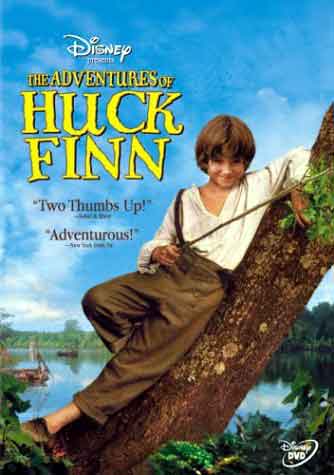| |
Here are some interesting notes about The Adventures
of Huck Finn, which have appeared in various trivia questions on Internet
boards or could well appear.
- Tom Sawyer in the original book had a much larger role.
In this film version, Tom is just one of the friends that root Huck
on during the opening fight scene and is not credited in the cast list.
- Director and Screenwriter, Stephen Sommers also wrote
the screenplay to the 1995 film Tom and Huck. His most famous
credit as writer is for The Mummy, The Mummy Returns and
The Scorpion King.
- Frances Conroy, who plays the Scrawny Shanty Lady,
is famous for her character acting; however, she shot to stardom and
won an Emmy Award for her portrayal on the American HBO series Six
Feet Under playing the part of the long suffering mother, Ruth Sibley.
- Robbie Coltrane, the Duke, is most famous to film going
audiences as the giant, Rubeus Hagrid in the three (soon to be four)
Harry Potter films.
- At the end of Huck Finn, Elijah Wood awakes
in a serene camera shot wrapped in white linen. This very same awakening
shot was recreated in two The Lord of the Rings films—Frodo awakes
in Rivendell in The Fellowship of the Ring and Frodo awakes in
the Houses of Healing in The Return of the King.
- Jason Robards Jr., the King of Bilgewater, was credited
without the "Jr." But in fact, most of his screen credits
include this, as his father (Jason Robards Sr.) was a famous film and
stage star of the 1930’s. JR Jr. also appeared in the highly acclaimed
film Philadelphia during the same year as Huck Finn—1993.
- Ron Perlman, who plays Papp Finn, is more famous for
his roles in Star Trek: Nemesis and The Chronicles of Riddick.
- The far shot of Elijah Wood at the rudder of the raft
is the picture image of Frodo’s first encounter with Gandalf (a shot
shared by Elijah and his size double) in The Fellowship of the Ring.
- Water plays a big role in Elijah Wood’s filmography
of this period. In Huck Finn he splashed around quite a bit.
In The War he struggles with a whirlpool and in Flipper,
he spends at least a quarter of his time submerged, either with his
co-star (Flipper) or in the havoc of a Hurricane. It’s a good thing
Elijah Wood is partial to the ocean and has said in early interviews
that if he chose a career other than acting it would be Oceanography.
Of course, he probably wouldn’t say that today. Ask him now and he’ll
say—Music Mogul, which he undoubtedly is on the path to becoming.
- The Adventures of Huckleberry Finn is Mark Twain’s
most successful and most notorious work. Dubbed The Great American
Novel by European Critics, Southern states banned it from Public
Libraries for years. Originally tied to the enormous success of the
children’s book, The Adventures of Tom Sawyer, Twain soon discovered
the sequel was far meatier, and filled with deeper meaning and texture,
a realization that many sequel writer’s face (just ask Tolkien, King
and Rowling). Twain’s sequel may not have been as weighty as The
Lord of the Rings, but it provides a powerful punch and is the one
Twain work that lingers in everyone’s memory.
|
|
